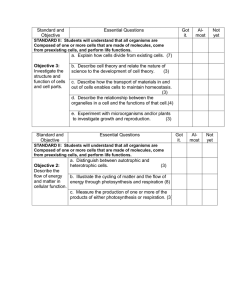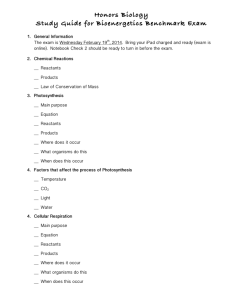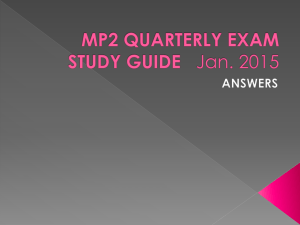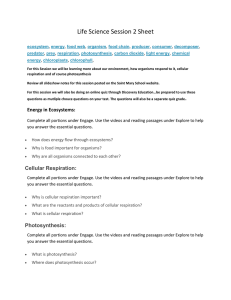Food Chains, Webs, Pyramids, & Energy (2.4 & 2.5)
advertisement
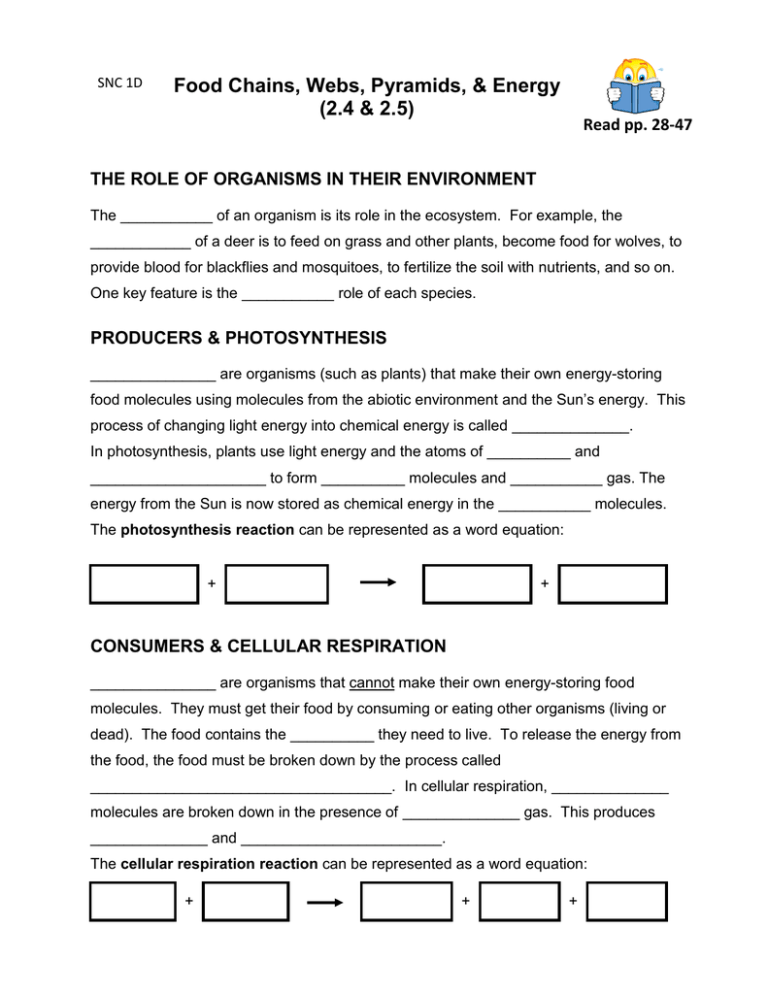
SNC 1D Food Chains, Webs, Pyramids, & Energy (2.4 & 2.5) Read pp. 28-47 THE ROLE OF ORGANISMS IN THEIR ENVIRONMENT The ___________ of an organism is its role in the ecosystem. For example, the ____________ of a deer is to feed on grass and other plants, become food for wolves, to provide blood for blackflies and mosquitoes, to fertilize the soil with nutrients, and so on. One key feature is the ___________ role of each species. PRODUCERS & PHOTOSYNTHESIS _______________ are organisms (such as plants) that make their own energy-storing food molecules using molecules from the abiotic environment and the Sun’s energy. This process of changing light energy into chemical energy is called ______________. In photosynthesis, plants use light energy and the atoms of __________ and _____________________ to form __________ molecules and ___________ gas. The energy from the Sun is now stored as chemical energy in the ___________ molecules. The photosynthesis reaction can be represented as a word equation: + + CONSUMERS & CELLULAR RESPIRATION _______________ are organisms that cannot make their own energy-storing food molecules. They must get their food by consuming or eating other organisms (living or dead). The food contains the __________ they need to live. To release the energy from the food, the food must be broken down by the process called ____________________________________. In cellular respiration, ______________ molecules are broken down in the presence of ______________ gas. This produces ______________ and ________________________. The cellular respiration reaction can be represented as a word equation: + + + Show the relationship between producers & consumers, and photosynthesis & cellular respiration by filling in the boxes in the following diagram. Photosynthesis (Producers) Cellular Respiration (Consumers) TYPES OF CONSUMERS ____________________ Animals that feed on plants only. ex. deer, mice, cows, rabbits ____________________ Animals that feed on other animals only. ex. wolves, eagles, lions, sharks Carnivores that feed on live animals are called predators. ____________________ Animals that feed on both plants and other animals. ex. black bear, humans ____________________ Animals that feed on dead plants or animals Scavengers do not usually kill their own food ex. vultures, snails, crayfish, crows ____________________ A special group of consumers that feeds on dead plants and animals, and animals wastes. They differ from scavengers in that they do not actually eat the dead material; they give off digestive juices that break down the dead matter into simple molecules. Some molecules (nutrients) are absorbed by the decomposers, while other molecules are returned to the environment for producers to use (decomposers recycle dead matter). ex. bacteria, fungi (mushrooms, mould) FOOD CHAINS Food chains show the feeding relationships between species. A food chain describes a feeding sequence in which an organism is eaten by the next organism in the chain. All food chains begin with a _______________ and include one or more __________________. A food chain also shows a flow of _____________. TROPHIC LEVELS The consumers in a food chain are often classified according to their diet (i.e. herbivore, carnivore, and omnivore). To classify consumers more precisely, ecologists use trophic levels or ______________ levels. A trophic level tells how directly a consumer interacts with the producers. Food Chain Organism Trophic Level Other Classifications hawk carnivore 3rd order consumer snake carnivore 2nd order consumer mouse herbivore 1st order consumer grass producer FOOD WEBS In most ecosystems, food chains do not exist on their own because the organisms in the food chain usually eat more than one kind of food. What results is an arrangement of interconnecting food chains called a _________________. For the food web above; 1. Identify the producers by placing the letter “P” by their picture. 2. Place the number “1” beside the 1st order consumers (herbivores). 3. Place the number “2” beside the 2nd order consumers (carnivores). 4. Place the number “3” beside the 3rd order consumers (carnivores). 5. Place the number “4” beside the 4th order consumers (carnivores). 6. How many food chains make up this food web? __________ ENERGY FLOW IN ECOSYSTEMS The sun is the source of energy for almost all ecosystems. Producers capture some of this energy in photosynthesis to form food. Only _____% of the sun’s energy is absorbed by plants for photosynthesis (_____% is absorbed by the Earth’s atmosphere, land, and water, and the remaining 30% is ____________ by the Earth). Not all of the captured energy is stored in plant tissue; some of this energy is used by plants for growth, cell reactions, flowering etc. Herbivores (i.e. rabbits) that eat plants do not store all the energy in their tissues. Some energy is used for movement, growth, cell activities etc. Much of the energy is lost as ____________. Thus, energy is gradually ____________ along a food chain. With each transfer, more energy escapes into the environment, never to be reused or recycled. ECOLOGICAL PYRAMIDS Since food chains only show transfer of energy through an ecosystem, food pyramids are used to study different aspects of ecosystems. There are 3 types of food pyramids. Pyramid of ___________________ - based on the # of organisms at each trophic level - usually, the most numerous organisms are the producers and the least numerous are the top-order consumers Pyramid of ___________________ - based on the total mass of organisms at each trophic level - usually, the producer trophic level has the greatest mass and the top-order consumers have the lowest mass Pyramid of ___________________ - based on the total amount of food energy available at each trophic level - in all cases, the producer trophic level has the greatest amount of energy and the toporder consumers have the least amount of energy QUESTIONS from textbook: p. 41 # 1, 2, 3, 5, 6, 7, 10 p. 47 # 3-8 Words for blanks: carbon dioxide (5) carnivores cellular respiration consumers (2) decomposers energy (3) feeding (2) food web heat herbivores light energy (2) lost niche (2) omnivores oxygen (5) photosynthesis producers (2) reflected scavengers sugar (5) water (5)


